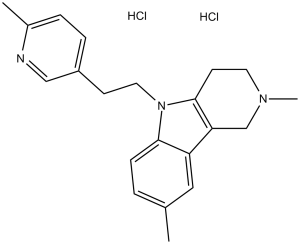This product is for research use only, not for human use. We do not sell to patients.

| Size | Price | Stock |
|---|---|---|
| 500mg | $980 | Check With Us |
| 1g | $1580 | Check With Us |
| 5g | $4265 | Check With Us |
Cat #: V0966 CAS #: 97657-92-6 Purity ≥ 98%
Description: Latrepirdine HCl (Dimebon; Dimebolin; Dimeboline; Preparation 84), the hydrochloride salt of Latrepirdine, is an orally bioactive, neuroactive and non-selective antihistamine drug with the potential to be used for Alzheimer's disease and Huntington's disease.
Publications Citing InvivoChem Products
Product Promise

- Physicochemical and Storage Information
- Protocol
- Related Biological Data
- Stock Solution Preparation
- Quality Control Documentation
| Molecular Weight (MW) | 392.37 |
|---|---|
| Molecular Formula | C21H25N3.2HCl |
| CAS No. | 97657-92-6 |
| Storage | -20℃ for 3 years in powder formr |
| -80℃ for 2 years in solvent | |
| Solubility In Vitro | DMSO: 24 mg/mL (61.2 mM)r |
| Water: <1 mg/mLr | |
| Ethanol: 13 mg/mL (33.1 mM) | |
| SMILES Code | CC1=CC=C(CCN2C3=C(CN(C)CC3)C4=C2C=CC(C)=C4)C=N1 |
| Synonyms | Dimebon; Dimeboline; Dimebolin; Latrepirdine; Preparation 84; |
| Protocol | In Vitro | Latrepirdine has been reported to possess several properties that are potentially relevant to the treatment of neurodegenerative diseases:(1) stabilization of mitochondrial function and calcium homeostasis;(2) protection of cultured cells from the cytotoxicity of amyloid-β (Aβ) peptide; (3) modulation of Aβ release from cultured cells, isolated intact nerve terminals, and from hippocampal neurons in living mouse brain; |
|---|---|---|
| In Vivo | Latrepirdine treatment of TgCRND8 transgenic mice is associated with improved learning behavior and with a reduction in accumulation of Aβ42 and α-synuclein. Male, 90-day-old TgCRND8 mice or their wild-type littermates (nTg) receive 31 consecutive once daily i.p. injections of either 3.5 mg/kg Latrepirdine or 0.9% saline (vehicle). At the culmination of treatment, mice are tested for cued and contextual fear conditioning using a paradigm that has been widely accepted for evaluating learning and memory deficits in APP transgenic mice. A significant increase in cued memory only among Latrepirdine-versus vehicle-treated TgCRND8 mice (p=0.01) is observed. A weak, non-significant trend toward an improvement in contextual memory among Latrepirdine-versus vehicle-treated mice (p=0.099) is also observed |
| Solvent volume to be added | Mass (the weight of a compound) | |||
|---|---|---|---|---|
| Mother liquor concentration | 1mg | 5mg | 10mg | 20mg |
| 1mM | 2.5486 mL | 12.7431 mL | 25.4861 mL | 50.9723 mL |
| 5mM | 0.5097 mL | 2.5486 mL | 5.0972 mL | 10.1945 mL |
| 10mM | 0.2549 mL | 1.2743 mL | 2.5486 mL | 5.0972 mL |
| 20mM | 0.1274 mL | 0.6372 mL | 1.2743 mL | 2.5486 mL |
This equation is commonly abbreviated as: C1 V1 = C2 V2
- (1) Please be sure that the solution is clear before the addition of next solvent. Dissolution methods like vortex, ultrasound or warming and heat may be used to aid dissolving.
- (2) Be sure to add the solvent(s) in order.




































